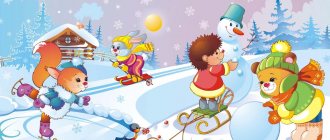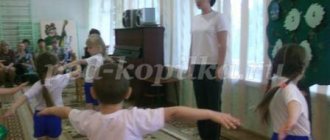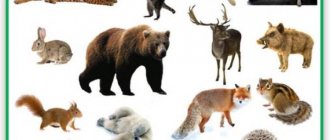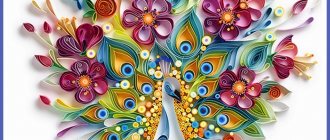Project “Animals of our region” for children of the middle group of preschool educational institutions
- July 19, 2016
This environmental project will help preschoolers expand their knowledge about wild animals of the forests of the Kaliningrad region.
As a result of the project, it is planned to create a book “Wild Animals of Our Forests.” The goal of the project: to create conditions for the development of children’s cognitive and creative abilities in the process of developing the child-adult educational project “Animals of our region.”
Project objectives:
1. Enrich and consolidate the knowledge and ideas of preschoolers about animals living in our forests.
2. Enrich children’s vocabulary with names of signs and actions by designating qualities (features of appearance, nutrition, habits).
3. Develop children’s coherent speech through writing a descriptive story about animals and retelling a literary text.
4. Foster a culture of communication by listening to the stories of your comrades without interrupting the speaker.
Relevance of the topic
Children in the middle group of kindergarten have insufficient ideas about the animals of our forests, their cubs, their appearance, living conditions, and habits. They find it difficult to compose a coherent statement about a subject because they do not have sufficient knowledge and vocabulary; they need the help of an adult in planning a story. The participation of children in the project “Animals of our region” will enrich their knowledge and ideas about wild animals and their cubs, the characteristics of the life of animals; develop coherent speech and creative abilities of children.
Fundamental question: Can our planet exist without animals?
Problematic question: Why can’t wild animals live in an apartment?
Project participants : teachers, parents and children of the middle group, ecologist, music director, physical education director.
The nature of the project activity: cognitive and creative.
Expected outcome for children:
In the process of implementing the project, children will learn:
- Know and name the animals of our forests, their appearance, habits, adaptations to their environment (seasonal changes, methods of protection).
- Possess the general concept of “wild animals”.
- Compare animals based on several characteristics, finding similarities and differences.
- Write a descriptive story about an animal using a diagram.
- Coherently and consistently convey the content of a literary text based on subject pictures.
- To be able to use various materials together with parents to create an image of an animal, to select interesting educational material about this animal.
As a result of the project, the book “Wild Animals” will be created.
Expected outcome for the teacher:
Presentation of the project “Animals of our region”, design of the book “Wild Animals”.
Long-term plan for the project “Animals of our region”
| Areas of work | Collaborative activities between teachers and children |
| Play activity | 1. Role-playing games: “Zoo”, “Pet shop”, “In a forest clearing”. 2. Didactic games: “Who lives where”, “Who eats what”, “Whose children?”, “Where is whose mother?” 3. Game - dramatization of Russian folk tales “Teremok”, “Rukavichka”, “Winter quarters of animals” |
| Communication activities | 1. Compiling stories about animals and creating a book of stories. 2. Enriching children's vocabulary.
|
| Reading fiction | Reading Russian folk tales “Sister Fox and the Gray Wolf”, “Tails”, “Bragging Hare”, “Fear has Big Eyes”, “Zayushkina’s Hut”, “Fox with a Rolling Pin; stories from T.A.'s manual Shorygina “What animals are in the forest?”: Hedgehog, Bear, Fox; memorizing poems about animals: “Squirrel Paratrooper”, “Fox” by I. Novikov. |
| Cognitive and research activity |
|
| Productive activity |
|
| Theatrical activities | 1. Tabletop theater “Zoo”. 2. Improvisation “Zayushkina’s Hut”. |
| Motor activity |
|
| Creative activity |
|
Contents of the project “Animals of our region”
| Project stages | Activities of a teacher | Interaction with family | Activities with children |
| Introductory | Introduces a problematic situation: Why can’t a fox (hare, wolf, hedgehog, squirrel) live in an apartment? | Analyze the situation with children. Visit parents and children to the zoo to study the wild animals of our region. | Take part in the discussion |
| Activity planning | Planning the content of work with parents on the speech development of children within the framework of the topic “Wild Animals”. | Consultative work with parents. | Building a system of working with children: long-term planning of developmental situations, activities to create a subject-specific developmental environment that allows children, independently or under the guidance of a teacher, to determine the content of the activity, outline an action plan, distribute their time and actively participate in the learning and upbringing process, interacting with each other , teacher, parents. |
| Project implementation | The teacher organizes, directs and corrects the cooperation of adults and children, encourages the efforts of both parties. | Watching TV shows about animals at home. | Joint activities of the teacher with children according to a long-term plan. |
| Project presentation | Creation of the book “Wild Animals” | Provide assistance in collecting waste material. | Active participants. |
| Summarizing | Organizes the presentation and presentation of the created book “Wild Animals”. | Design of drawings with the compilation of descriptive stories about animals. | Creating a book about wild animals. Making crafts of wild animals from a variety of materials for exhibition in the mini-museum “Local History”. |
Long-term plan for working with parents within the framework of the project “Animals of our region”
| Direction to improve parental competence | Collaboration between teachers and parents | Joint activities between parents and children | Result |
| Information and analytical | Introduce parents to the proposed project | Maintain interest in this topic through conversations, observations, etc. | Parents receiving information about upcoming work |
| Cognitive | Consultation: “Introducing senior preschool children to animals” | Reading encyclopedias about animals; viewing illustrations, TV shows about animals Homework for the weekend: “Drawing up drawings of wild animals in our forests and writing a descriptive story.” | Raising children's interest and love for nature Replenishment of the subject-development environment:
|
| Visual and informational | Folder: “Games to help you learn more about wild animals” Information for parent corners with seasonal changes in nature | Homework for parents and children to activate and enrich vocabulary on this topic | Development of the grammatical structure of speech in a child:
|
Application
GAMES, POEMS AND EXERCISES ON THE TOPIC “ANIMALS OF OUR FORESTS”
GAME TO DEVELOP WORD COORDINATION WITH MOVEMENT “AT THE WATERING POOL”
On a hot day, along a forest path (children walk in a circle, one after another), the animals went to a watering hole. A moose calf was stomping behind the mother elk, (they walk, stomping loudly) A little fox was sneaking behind the mother fox, (sneaking on tiptoes) A hedgehog was rolling behind the mother hedgehog, (crouches, slowly moving forward) A bear cub was following the mother bear, (they waddle) The squirrel cubs galloped after the mother squirrel, (jumping in a squat position) Behind the mother hare, the slanting hares, (jumping on straight legs) The she-wolf led the wolf cubs, (walking on all fours) All the mothers and children want to get drunk. (face in a circle, make movements with the tongue - “lap”)
FINGER GYMNASTICS “EVERYONE HAS THEIR OWN HOME”
A fox in a deep forest has a hole - a safe home. (children bend their fingers on the squirrel in the hollow of a spruce tree. Both hands: one at a time. Under the bushes, a prickly hedgehog rakes leaves into a pile. a finger on each line) Beavers make huts from branches, roots, and bark. The clubfoot sleeps in the den, and he sucks his paw until spring. Everyone has their own home, everyone is warm and comfortable in it. (strikes with palms and fists alternately)
OUTDOOR GAMES
“Empty space” “Recognize by voice”
I walk in circles and look out the window. We walk in a circle, I’ll go up to one and knock softly. We call the fox, - Knock-knock! Let him not open his eyes, - Who is there? He recognizes us by our voice. — …….. (Sasha) — Why did you come? - They ran in a race like ....... (hares, bears, foxes, etc.)
POEMS ABOUT ANIMALS (Vl. Stepanov)
Bear. Squirrel.
Through the rubble, along the ravines, Squirrel - with tasseled ears - The animal walks with a master's step. He sees a mushroom at the edge of the forest - He loves fragrant honey, Jumps after it from the thick branches and picks raspberries from the branches. And he carries it home quickly.
Boar. Elk.
The fog falls, the elk has branched antlers, the boar wakes up. Yes, the hooves are fast. Digging the ground by the river, Shaking his head, he sharpens his sharp fangs. Touches the sky.
Hedgehog. Badger.
The gray hedgehog is covered in needles, The badger gets up after midnight, As if he is not an animal, but a Christmas tree. He will walk around his house. Even though the forest is prickly and silent - A keen sense of smell and a keen eye - The hedgehog is kind, not evil. The hour of hunting has come.
Author: Korkunova E.S. teacher of the first qualification category of the municipal autonomous preschool educational institution kindergarten No. 3 “Bell” of the Pionersky urban district of the Kaliningrad region.
Summary of an open lesson on speech development in the middle group “Wild and Domestic Animals”
Summary of an open lesson on speech development in the middle group “Wild and Domestic Animals”
Summary of an open lesson on speech development in the middle group “Wild and Domestic Animals”
Goal: Formation of cognitive and speech activity in children.
Tasks:
— consolidate children’s knowledge about the distinctive features of domestic and wild animals
;
- consolidate children’s knowledge in naming baby animals
;
— develop attention
, thinking and imagination, speech activity;
- cultivate a caring attitude towards nature and its inhabitants.
— activate children’s vocabulary, clarify the names of animals
. Where do they live?
- strengthen the ability to use in speech
nouns denoting
animals
.
— develop attention
, memory, ability to clearly pronounce words and sentences.
Educational:
— consolidation of knowledge about domestic and wild animals
.
- developing in children an idea of the diversity of the animal world
.
— develop
Creative skills.
Educational:
- cultivate interest in family
,
wild animals
.
Integration: Cognition, communication, socialization.
Preliminary work:
Looking at pictures of animals
, illustrations (
wild animals in the forest
,
pets in the village
,
animals with cubs
, a dog in a kennel, a squirrel in a hollow, a bear in a den, etc., reading stories (B. Zhidkov
“Evening”
,
“Brave Duckling”
,
“ Stray Cat”
, V. Bianki
“Mouse Peak”
, fairy tales (Russian folk tales
“The Wolf and the Seven Little Goats”
,
“Swan Geese”
,
“Crane and Heron”
,
“The Fox and the Hare”
, etc.,
“The Three Little Pigs”
S. V. Mikhalkova,
“The Ugly Duckling”
by H. H. Andersen, asking riddles Not an animal, not a bird, but afraid of everyone, catching flies and splashing into the water
(frog)
, etc., looking at
animal
.
Didactic games: “ Wild and domestic animals ”
.
"The Fourth Wheel"
.
Round dance games: “At the bear in the forest”
.
"We are walking through the forest"
.
Material:
Interactive whiteboard, pictures of wild and domestic animals
.
Contents of organized educational activities for children
1. Organizational moment
guests came to our lesson today
, let's say hello to them.
Music sounds ( animal )
.
- children, whose voices are these? (horse, cow, cat, elephant)
.
— how can you call them in one word? ( animals )
- what animals
?
( wild and domestic )
Today we will remember domestic
,
wild animals and their young
, where they live.
— Tell me, what is the difference between domestic animals and wild ones
?
(Place of residence, obtaining food)
.
(Children's answers)
.
Educator - Children today I invite you to the wonderful world of animals
. You are ready to go on a journey. Well, let's begin then!



